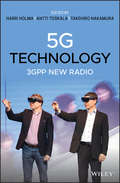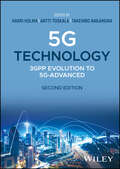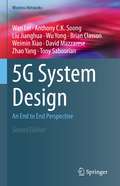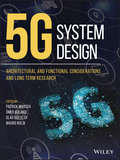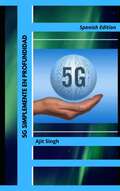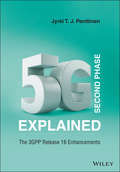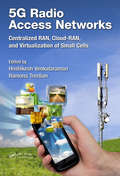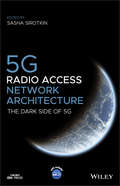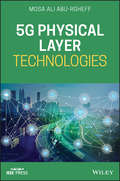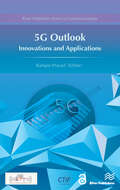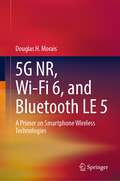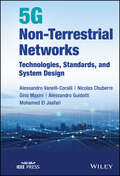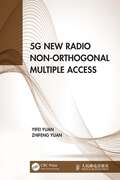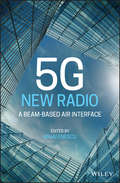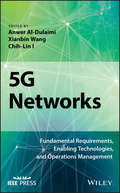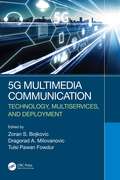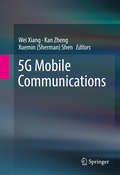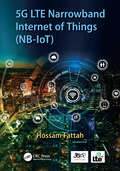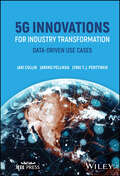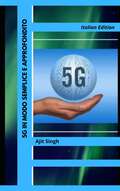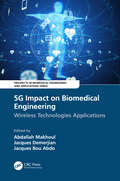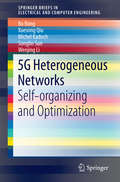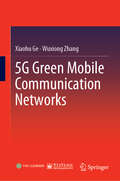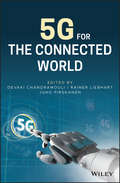- Table View
- List View
5G Technology: 3GPP New Radio
by Harri HolmaA comprehensive guide to 5G technology, applications and potential for the future 5G brings new technology solutions to the 5G mobile networks including new spectrum options, new antenna structures, new physical layer and protocols designs and new network architectures. 5G Technology: 3GPP New Radio is a comprehensive resource that offers explanations of 5G specifications, performance evaluations, aspects of device design, practical deployment considerations and illustrative examples from field experiences. With contributions from a panel of international experts on the topic, the book presents the main new technology components in 5G and describes the physical layer, radio protocols and network performance. The authors review the deployment aspects such as site density and transport network and explore the 5G performance aspects including data rates and coverage and latency. The book also contains illustrative examples of practical field measurement. In addition, the book includes the most recent developments in 4G LTE evolution and offers an outlook for the future of the evolution of 5G. This important book: Offers an introduction to 5G technology and its applications Contains contributions from international experts on the topic Reviews the main technology components in 5G Includes information on the optimisation of the Internet of things Presents illustrative examples of practical field measurements Written for students and scientists interested in 5G technology, 5G Technology: 3GPP New Radio provides a clear understanding of the underlying 5G technology that promotes the opportunity to take full benefit of new capabilities.
5G Technology: 3GPP Evolution to 5G-Advanced
by Harri Holma Antti Toskala Takehiro Nakamura5G TECHNOLOGY An Essential Insider’s View of the Development Work of 5G Technology Up to Release 18 5G brings new technology solutions to the 5G mobile networks, including new spectrum options, antenna structures, physical layer and protocols designs, and network architectures. 5G Technology: 3GPP Evolution to 5G-Advanced is an accessible and comprehensive resource that offers explanations of 5G specifications and performance evaluations, aspects of device design, practical deployment considerations and illustrative examples from field experiences. With contributions from a panel of international experts on the topic (industry insiders working at the forefront of development), the book presents the main new technology components in 5G and describes the physical layer, radio protocols, and network performance indicators associated with them. It has intentionally been written to cater to individuals at all levels of 5G expertise. Some of the topics of discussion and learning resources in the work include: An easy-to-understand insider’s overview of 5G from editors and authors who are actively working with the 5G development in 3GPP, the forum defining the requirements Deployment aspects, such as site density and transport network, plus exploration into 5G performance aspects, including data rates, coverage, and latency A large number of illustrations including simulation and measurement results of 5G technology performance, plus key 5G procedures Updated information on industrial IoT, radio enhancements in Releases 16 and 17, open RAN and virtualized RAN, 5G verticals and new use cases, and the 5G-Advanced development in Release 18 and outlook towards Release 19 5G Technology: 3GPP Evolution to 5G-Advanced serves as a complete resource for wireless researchers, network planners, lecturers in universities, technology analysts, R&D engineers, application developers, and spectrum regulators who wish to thoroughly understand the latest in 5G technology and get ahead of the curve with regards to its potential applications in a wide variety of industries.
5G System Design: An End to End Perspective (Wireless Networks)
by Wan Lei Liu Jianghua Wu Yong Brian Classon Weimin Xiao David Mazzarese Zhao Yang Tony Saboorian Anthony C.K. SoongThis book presents a detailed pedagogical description of the 5G commercial wireless communication system design, from an end to end perspective, by those that were intimate with its development. The exposition only assumes that the reader is passingly familiar with LTE and builds upon that knowledge. By comparing and contrasting NR with LTE, it allows for quick mastering of 5G. As such it gives concise and highly accessible description of the key technologies in the 5G physical layer, radio access network layer protocols and procedures, how the 5G core and EPC is integrated into the radio access network, how virtualization, slicing and edge computer will fundamentally change the way we interact with the network, as well as 5G spectrum issues.The 2nd edition of this book significantly enhances and updates the first edition by adding 5G security and Release-16 developments. Loosely speaking, 5G Release-15 can be characterized as being optimized for the cellular carrier eMBB service while 5G Release-16 is the beginning of the optimization of 5G for the vertical industries. It mainly focused on the support of the vehicular vertical and Industrial Internet of Things. As such, we have significantly altered the first edition to cover the key features standardized in Release-16 including: URLLC, V2X, IIoT, enhanced MIMO, unlicensed access, positioning, power savings and IAB. On the network side, detailed discussion covers NR security as well as the newly standardized access traffic steering, non 3GPP access switching and splitting features, non 3GPP access network support and private networks.Engineers, computer scientists and professionals from those with a passing knowledge of 4G LTE to experts in the field will find this book to be a valuable asset. They will gain a comprehensive understanding of the end to end 5G commercial wireless system. Advanced-level students and researchers studying and working in communication engineering, who want to gain an understanding of the 5G system (as well as methodologies to evaluate features and technologies intended to supplement 5G) will also find this book to be a valuable resource.
5G System Design: Architectural and Functional Considerations and Long Term Research
by Patrick Marsch Ömer Bulakci Olav Queseth Mauro BoldiThis book provides a comprehensive overview of the latest research and standardization progress towards the 5th generation (5G) of mobile communications technology and beyond. It covers a wide range of topics from 5G use cases and their requirements, to spectrum, 5G end-to-end (E2E) system architecture including core network (CN), transport network (TN) and radio access network (RAN) architecture, network slicing, security and network management. It further dives into the detailed functional design and the evaluation of different 5G concepts, and provides details on planned trials and pre-commercial deployments across the globe. While the book naturally captures the latest agreements in 3rd Generation Partnership Project (3GPP) New Radio (NR) Release 15, it goes significantly beyond this by describing the likely developments towards the final 5G system that will ultimately utilize a wide range of spectrum bands, address all envisioned 5G use cases, and meet or exceed the International Mobile Telecommunications (IMT) requirements for the year 2020 and beyond (IMT-2020). 5G System Design: Architectural and Functional Considerations and Long Term Research is based on the knowledge and consensus from 158 leading researchers and standardization experts from 54 companies or institutes around the globe, representing key mobile network operators, network vendors, academic institutions and regional bodies for 5G. Different from earlier books on 5G, it does not focus on single 5G technology components, but describes the full 5G system design from E2E architecture to detailed functional design, including details on 5G performance, implementation and roll-out.
5G Simplemente en Profundidad
by Ajit Singh5G Technologies es una visión y definición de la Tecnología 5G es introducida, así como varias técnicas clave que permiten la Tecnología 5G. Este libro provee un panorama de las características clave de la quinta Generación (5G) de redes móviles, discutiendo la motivación para 5G, arquitectura, implementación, modelos de referencia, retos en el desarrollo de esta nueva tecnología. Este libro provee una vista dentro de las áreas clave de desarrollo que definirán este nuevo sistema tecnológico, preparando la ruta a través de investigación futura y desarrollo. Este libro pretende cubrir el panorama 5G, incluyendo Internet Futuro, computación en nube, celdas pequeñas y redes auto-organizadas (SONs), comunicaciones cooperativas, y radio cognitivo, convergencia radio difusión-banda ancha, retos de seguridad 5G. Facilidades clave: • Aborda los fundamentales de redes móviles 5G, sirviendo como una guía de estudio para investigadores e ingenieros de sistemas móviles con el objetivo de posicionar su investigación en este escenario de rápida evolución. • Desarrolla la historia de celdas pequeñas junto con la nueva generación de sistemas SON (redes auto-organizadas) como soluciones para dirigir la demanda de tráfico sin precedente y variaciones a través de celdas. • Explica la tecnología de Nube Móvil y Servicios par plataformas futuras de comunicación. • Discute los temas abiertos encarando la implementación a escala comercial amplia de redes de espacio blanco, incluyendo el potencial para aplicaciones hacia el estándar futuro de 5G. • Describe los componentes clave, tendencias y retos, así como los requerimientos de sistemas para transceivers de 5G a radios de soporte multi estándar, una fuente de inspiración por los ingenieros de RF. Este libro serviría como una guía ideal para B.E., B.Tech., B.S., B.Sc, B.C.A., estudiantes univers
5G Second Phase Explained: The 3GPP Release 16 Enhancements
by Jyrki T. J. Penttinen5G SECOND PHASE EXPLAINED A one-stop reference that offers an accessible guide to an understanding of the enhanced core technologies of 5G 5G Second Phase Explained – The 3GPP Release 16 Enhancements offers an authoritative and essential guide to the new functionalities of the Release 16 that complement the first phase of the 5G. From the author of 5G Explained comes the next step resource that includes detailed descriptions that provide a clear understanding to the full version of the 5G technologies and their impacts on the Phase 1 networks.The author—an industry expert—not only reviews the most up-to-date functionalities of the Release 16 but includes information on the forthcoming Release 17 as well as material on future developments. The book explores the highly unique aspects of the Release 16, which can help technical personnel’s efforts to deliver essential information in a practical way. The two books, 5G Explained and 5G Second Phase Explained, offer a comprehensive understanding of 5G. This important guide:Offers a summary of the newest and key features of 5GPresents a one-stop reference for an understanding of the core technologies of 5GContains a new book that expands on the author’s 5G ExplainedPuts the focus on security and deployment aspects of 5G enhancementsWritten for technical personnel of network operators, network element and user device manufacturers, 5G Second Phase Explained offers a guide to an understanding of network deployment and device designing of 5G technologies.
5G Radio Access Networks: Centralized RAN, Cloud-RAN and Virtualization of Small Cells
by Hrishikesh Venkatarman Ramona TrestianC-RAN and virtualized Small Cell technology poses several major research challenges. These include dynamic resource allocation, self-configuration in the baseband pool, high latency in data transfer between radio unit and baseband unit, the cost of data delivery, high volume of data in the network, software networking aspects, potential energy savings, security concerns, privacy of user’s personal data at a remote place, limitations of virtualized environment, etc. This book provides deeper insights into the next generation RAN architecture and surveys the coexistence of SDN, C-RAN and Small Cells solutions proposed in the literature at different levels.
5G Radio Access Network Architecture: The Dark Side of 5G (Wiley - IEEE)
by Sasha SirotkinWritten by an industry insider with state of the art research at their fingertips, this book describes the Radio Access Network (RAN) architecture, starting with currently deployed 4G, followed by the description of 5G requirements and why re-thinking of the RAN architecture is needed to support these. Based on these considerations, it explains how 5G network architecture, which is currently being defined, is likely to evolve. The aim is not merely to cover relevant standards and technologies as a purely academic exercise (although a significant part of the book will be dedicated to these), but to augment these by practical deployment, to illustrate why the RAN architecture is changing and where it is going. With 5G deployments on the horizon, there is a desire within companies to both re-think the RAN architecture and to change the proprietary nature of the RAN. Correspondingly, there is increased interest in academia, standards bodies and commercial entities involved in the area.
5G Physical Layer Technologies (Wiley - IEEE)
by Mosa Ali Abu-RgheffWritten in a clear and concise manner, this book presents readers with an in-depth discussion of the 5G technologies that will help move society beyond its current capabilities. It perfectly illustrates how the technology itself will benefit both individual consumers and industry as the world heads towards a more connected state of being. Every technological application presented is modeled in a schematic diagram and is considered in depth through mathematical analysis and performance assessment. Furthermore, published simulation data and measurements are checked. Each chapter of 5G Physical Layer Technologies contains texts, mathematical analysis, and applications supported by figures, graphs, data tables, appendices, and a list of up to date references, along with an executive summary of the key issues. Topics covered include: the evolution of wireless communications; full duplex communications and full dimension MIMO technologies; network virtualization and wireless energy harvesting; Internet of Things and smart cities; and millimeter wave massive MIMO technology. Additional chapters look at millimeter wave propagation losses caused by atmospheric gases, rain, snow, building materials and vegetation; wireless channel modeling and array mutual coupling; massive array configurations and 3D channel modeling; massive MIMO channel estimation schemes and channel reciprocity; 3D beamforming technologies; and linear precoding strategies for multiuser massive MIMO systems. Other features include: In depth coverage of a hot topic soon to become the backbone of IoT connecting devices, machines, and vehicles Addresses the need for green communications for the 21st century Provides a comprehensive support for the advanced mathematics exploited in the book by including appendices and worked examples Contributions from the EU research programmes, the International telecommunications companies, and the International standards institutions (ITU; 3GPP; ETSI) are covered in depth Includes numerous tables and illustrations to aid the reader Fills the gap in the current literature where technologies are not explained in depth or omitted altogether 5G Physical Layer Technologies is an essential resource for undergraduate and postgraduate courses on wireless communications and technology. It is also an excellent source of information for design engineers, research and development engineers, the private-public research community, university research academics, undergraduate and postgraduate students, technical managers, service providers, and all professionals involved in the communications and technology industry.
5G Outlook – Innovations and Applications: Innovations And Applications (River Publishers Series In Communications Ser.)
by Ramjee Prasad5G Outlook - Innovations and Applications is a collection of the recent research and development in the area of the Fifth Generation Mobile Technology (5G), the future of wireless communications. Plenty of novel ideas and knowledge of the 5G are presented in this book as well as divers applications from health science to business modeling. The authors of different chapters contributed from various countries and organizations. The chapters have also been presented at the 5th IEEE 5G Summit held in Aalborg on July 1, 2016. The book starts with a comprehensive introduction on 5G and its need and requirement. Then millimeter waves as a promising spectrum to 5G technology is discussed. The book continues with the novel and inspiring ideas for the future wireless communication usage and network. Further, some technical issues in signal processing and network design for 5G are presented. Finally, the book ends up with different applications of 5G in distinct areas. Topics widely covered in this book are: • 5G technology from past to present to the future• Millimeter- waves and their characteristics• Signal processing and network design issues for 5G• Applications, business modeling and several novel ideas for the future of 5G
5G NR, Wi-Fi 6, and Bluetooth LE 5: A Primer on Smartphone Wireless Technologies
by Douglas H MoraisThis book provides, at a high level and in a tractable fashion, a description of how wireless communications are achieved in the latest smartphones. The author shows how smartphones communicate via three separate systems, namely 5G NR, Wi-Fi 6, and Bluetooth Low Energy 5. He explains how 5G NR allows mobile voice and high-speed data communication, how Wi-Fi allows smartphone attachment to the Internet independent of 5G NR, and how Bluetooth allows smartphone attachment to speakers, in-car entertainment systems, smart watches, etc. This text explains the key basic technologies employed and then addresses how each system operates. This book is of interest to anyone with a rudimentary scientific understanding who desires to know more at an intuitive level rather than rigorous one how smartphones achieve wireless communications.
5G Non-Terrestrial Networks: Technologies, Standards, and System Design
by Alessandro Vanelli-Coralli Nicolas Chuberre Gino Masini Alessandro Guidotti Mohamed El Jaafari5G Non-Terrestrial Networks Provides a complete and detailed description of the non-terrestrial component in the 5G ecosystem 5G Non-Terrestrial Networks is the first multi-authored reference dedicated to the integration of non-terrestrial networks (NTN) into the 5G ecosystem. Written by leaders in the development of the 3GPP 5G NTN specification, this authoritative resource addresses all key aspects of non-terrestrial components of 5G systems, including standardization, architecture, protocols, and regulatory considerations. Drawing from their expertise in academic and industrial research and development, the authors introduce fundamental principles of non-terrestrial communications, define the NTN architecture and radio protocol stacks, describe applications to support mobility and radio resource management, and more. The book covers 5G New Radio-based technology for NTN as well as LTE NB-IoT/eMTC, providing a well-rounded understanding of the unique characteristics of 5G-NTN systems. Throughout the text, the authors offer insights on various design approaches, technical choices, and trade-off options. In addition, the book: Addresses the integration of non-terrestrial networks into 5G systems at all levels Describes the principles of non-terrestrial systems, including orbital parameters, link budget, propagation, and space/ground segments Includes a detailed overview of 5G-NTN system architectures, deployment scenarios, and spectrum aspects Covers NB-IoT and eMTC in NTN, NTN use cases, 5G QoS, and New Radio Discusses the potential of non-terrestrial components of 5G in the future 6G ecosystem 5G Non-Terrestrial Networks is a must-have for communication engineers, satellite network operators, aerospace and electrical engineers, network engineers, academic researchers and industry professionals involved in 5G infrastructure development, as well as advanced students taking courses on 5G and satellite communication.
5G New Radio Non-Orthogonal Multiple Access
by Yifei Yuan Zhifeng YuanThis book provides detailed descriptions of downlink non-orthogonal multiple transmissions and uplink non-orthogonal multiple access (NOMA) from the aspects of majorly used 5G new radio scenarios and system performance. For the downlink, the discussion focuses on the candidate schemes in 3GPP standards which are not only applicable to unicast services but also to broadcast/multicast scenarios. For the uplink, the main target scenario is massive machine-type communications where grant-free transmission can reduce signaling overhead, power consumption of devices and access delays. The design principles of several uplink NOMA schemes are discussed in-depth, together with the analysis of their performances and receiver complexities. Devoted to the basic technologies of NOMA and its theoretical principles, data analysis, basic algorithms, evaluation methodology and simulation results, this book will be an essential read for researchers and students of digital communications, wireless communications engineers and those who are interested in mobile communications in general.
5G New Radio: A Beam-based Air Interface
by Mihai EnescuA guide to the 3GPP-specified 5G physical layer with a focus on the new beam-based dimension in the radio system 5G New Radio: A Beam-based Air Interface is an authoritative guide to the newly 3GPP-specified 5G physical layer. The contributors—noted experts on the topic and creators of the actual standard—focus on the beam-based operation which is a new dimension in the radio system due to the millimeter wave deployments of 5G. The book contains information that complements the 3GPP specification and helps to connect the dots regarding key features. The book assumes a basic knowledge of multi-antenna technologies and covers the physical layer aspects related to beam operation, such as initial access, details of reference signal design, beam management, and DL and UL data channel transmission. The contributors also provide a brief overview of standardization efforts, IMT-2020 submission, 5G spectrum, and performance analysis of 5G components. This important text: Contains information on the 3GPP-specified 5G physical layer Highlights the beam-based operation Covers the physical layer aspects related to beam operation Includes contributions from experts who created the standard Written for students and development engineers working with 5G NR, 5G New Radio: A Beam-based Air Interface offers an expert analysis of the 3GPP-specified 5G physical layer.
5G Networks: Fundamental Requirements, Enabling Technologies, and Operations Management
by Anwer Al-Dulaimi Xianbin Wang Chih-Lin IA reliable and focused treatment of the emergent technology of fifth generation (5G) networks This book provides an understanding of the most recent developments in 5G, from both theoretical and industrial perspectives. It identifies and discusses technical challenges and recent results related to improving capacity and spectral efficiency on the radio interface side, and operations management on the core network side. It covers both existing network technologies and those currently in development in three major areas of 5G: spectrum extension, spatial spectrum utilization, and core network and network topology management. It explores new spectrum opportunities; the capability of radio access technology; and the operation of network infrastructure and heterogeneous QoE provisioning. 5G Networks: Fundamental Requirements, Enabling Technologies, and Operations Management is split into five sections: Physical Layer for 5G Radio Interface Technologies; Radio Access Technology for 5G Networks; 5G Network Interworking and Core Network Advancements; Vertical 5G Applications; and R&D and 5G Standardization. It starts by introducing emerging technologies in 5G software, hardware, and management aspects before moving on to cover waveform design for 5G and beyond; code design for multi-user MIMO; network slicing for 5G networks; machine type communication in the 5G era; provisioning unlicensed LAA interface for smart grid applications; moving toward all-IT 5G end-to-end infrastructure; and more. This valuable resource: Provides a comprehensive reference for all layers of 5G networks Focuses on fundamental issues in an easy language that is understandable by a wide audience Includes both beginner and advanced examples at the end of each section Features sections on major open research challenges 5G Networks: Fundamental Requirements, Enabling Technologies, and Operations Management is an excellent book for graduate students, academic researchers, and industry professionals, involved in 5G technology.
5G Multimedia Communication: Technology, Multiservices, and Deployment
by Zoran S. Bojkovic, Dragorad A. Milovanovic, and Tulsi Pawan FowdurIn bringing to the readers the book 5G Multimedia Communication: Technology, Multiservices and Deployment, the aim is to present current work and direction on the challenging subject of multimedia communications, with theoretical and practical roots. The past two decades have witnessed an extremely fast evolution of mobile cellular network technology. The fifth generation of mobile wireless systems has achieved the first milestone toward finalization and deployment by 2020. This is vital to the development of future multimedia communications. Also, it is necessary to consider 5G technology from the performance point of view by analyzing network capabilities to the operator and to the end user in terms of data rate, capacity, coverage, energy efficiency, connectivity and latency. The book is divided into three major parts with each part containing four to seven chapters: • Critical enabling technology • Multiservices network • Deployment scenarios The first part discusses enabling technologies, such as green communication, channel modeling, massive and distributed MIMO and ML-based networks. In the second part, different methodologies and standards for multiservices have been discussed. Exclusive chapters have been dedicated to each of the open research challenges such as multimedia operating in 5G environment, network slicing optimization, mobile edge computing, mobile video multicast/broadcast, integrated satellite and drone communication. The third part paved the way to deployment scenarios for different innovative services including integration of a multienergy system in smart cities, intelligent transportation systems, 5G connectivity in the transport sector, healthcare services, 5G edge-based video surveillance and challenges of connectivity for massive IoT in 5G and beyond systems. The book is written by experts in the field who introduced scientific and engineering concepts, covering the 5G multimedia communication areas. The book can be read cover-to-cover or selectively in the areas of interest for the readers. Generally, the book is intended for novel readers who could benefit from understanding general concepts, practitioners who seek guidance into the field and senior-level as well as graduate-level engineering students in understanding the process of today’s wireless multimedia communications.
5G Mobile Communications
by Xuemin Sherman Shen Kan Zheng Wei XiangThis book provides a comprehensive overview of the emerging technologies for next-generation 5G mobile communications, with insights into the long-term future of 5G. Written by international leading experts on the subject, this contributed volume covers a wide range of technologies, research results, and networking methods. Key enabling technologies for 5G systems include, but are not limited to, millimeter-wave communications, massive MIMO technology and non-orthogonal multiple access. 5G will herald an even greater rise in the prominence of mobile access based upon both human-centric and machine-centric networks. Compared with existing 4G communications systems, unprecedented numbers of smart and heterogeneous wireless devices will be accessing future 5G mobile systems. As a result, a new paradigm shift is required to deal with challenges on explosively growing requirements in mobile data traffic volume (1000x), number of connected devices (10-100x), typical end-user data rate (10-100x), and device/network lifetime (10x). Achieving these ambitious goals calls for revolutionary candidate technologies in future 5G mobile systems. Designed for researchers and professionals involved with networks and communication systems, 5G Mobile Communications is a straightforward, easy-to-read analysis of the possibilities of 5G systems.
5G Mobile and Wireless Communications Technology
by Osseiran, Afif and Monserrat, Jose F. and Marsch, Patrick Afif Osseiran Jose F. Monserrat Patrick MarschWritten by leading experts in 5G research, this book is a comprehensive overview of the current state of 5G. Covering everything from the most likely use cases, spectrum aspects, and a wide range of technology options to potential 5G system architectures, it is an indispensable reference for academics and professionals involved in wireless and mobile communications. Global research efforts are summarised, and key component technologies including D2D, mm-wave communications, massive MIMO, coordinated multi-point, wireless network coding, interference management and spectrum issues are described and explained. The significance of 5G for the automotive, building, energy, and manufacturing economic sectors is addressed, as is the relationship between IoT, machine type communications, and cyber-physical systems. This essential resource equips you with a solid insight into the nature, impact and opportunities of 5G.
5G LTE Narrowband Internet of Things (NB-IoT)
by Hossam FattahThis book explains the 3GPP technical specifications for the upcoming 5G Internet of Things (IoT) technology based on latest release which is Release 15. It details the LTE protocol stack of an IoT device, architecture and framework, how they are functioning and communicate with cellular infrastructure, and supported features and capability. NB-IoT is designed to connect a large number of devices in a wide range of application domains forming so-called Internet of Things (IoT). Connected devices are to communicate through cellular infrastructure. This technology is new within the 3GPP specifications and is part of upcoming new wireless technology known as 5G. Table of Contents Preface. Acknowledgments. Author. List of Abbreviations. 1. Internet of Things. 2. 4G and 5G Systems. 3. Radio Resource Control Sublayer. 4. Packet Data Convergence Protocol Sublayer. 5. Radio Link Control Sublayer. 6. Medium Access Control Sublayer. 7. Physical Sublayer. 8. Quality of Service Architecture. 9. Use Cases and Deployment. References. Index.
5G Innovations for Industry Transformation: Data-driven Use Cases
by Jari Collin Jarkko Pellikka Jyrki T. Penttinen5G INNOVATIONS FOR INDUSTRY TRANSFORMATION Authoritative resource providing insight on real-life industrial 5G use cases in driving customer value, productivity, and sustainability ambitions With 5G innovations rapidly expanding to different areas within technology, 5G Innovations for Industry Transformation provides key information on how 5G technology can positively impact digital transformation in the industry sectors, discussing new data-driven business opportunities, including green digital transition, new standards for sustainability, and real-time data-driven services, introducing case studies that cover a variety of industries, from the oil & gas industry to the telecom industry, along with the lessons learned from these case studies, and providing insights into how 5G technology will transform businesses by sharing real-time customer solutions, fair data sharing principles, and ecosystem and change management. The book summarizes novelty aspects in a compact and practical way to benefit users and specialists in the field who want to understand some of the very key aspects of 5G. To aid in reader comprehension, the book contains tables, figures of technical principles and architectural block diagrams, and photographs further explaining key topics. Sample topics covered in 5G Innovations for Industry Transformation include: 5G SA technology with new capabilities, 5G private networks, and how smart, connected products are transforming competition Implications of 5G applied to your particular business and/or industry, and how to scale up and industrialize based on these implications How to lead the charge in relation to optimizing business practices based on the advent of 5G, and details on navigating the platform economy How 5G affects data privacy and security, and other integrated capabilities of 5G, such as processes, data, technology, and competencies Based on real-world experiences and high-quality research and presenting practical examples that serve as a useful guiding hand, 5G Innovations for Industry Transformation is an essential resource for change leaders, enterprise architects, and software developers of any industrial enterprise seeking to drive digitalization forward in their value chain and organization.
5G in Modo Semplice e Approfondito
by Ajit SinghLa quinta generazione di tecnologie di accesso wireless (5G) si trova di fronte all'arduo compito di soddisfare le costanti richieste di velocità di trasmissione dati e capacità di sistema più elevate, nonché di un'ampia gamma di applicazioni e di requisiti di qualità dell'esperienza (QoE) degli utenti. Sebbene non sia ancora standardizzata, la tecnologia 5G dovrebbe offrire un throughput significativamente più elevato rispetto all'evoluzione a lungo termine (LTE), avere una latenza nell'ordine dei millisecondi ed essere in grado di accogliere e supportare la prevista esplosione dei dispositivi dell'Internet delle cose (IoT). Nuovi tipi di dispositivi (ad esempio sonde, contatori, sensori, attuatori) contribuiranno in modo significativo all'aumento del traffico e nuovi settori di mercato porteranno nuove priorità (ad esempio le infrastrutture critiche). Questo libro è una panoramica completa dello stato attuale del 5G. Spiega tutto, dai casi d'uso più probabili, agli aspetti dello spettro, da un'ampia gamma di opzioni tecnologiche alle potenziali architetture di sistema 5G, ed è un riferimento indispensabile per accademici e professionisti coinvolti nelle comunicazioni wireless e mobili. Vengono riassunti gli sforzi di ricerca a livello mondiale e vengono descritte e spiegate le tecnologie dei componenti chiave, tra cui D2D, comunicazioni a onde millimetriche, massive MIMO, coordinated multi-point, codifica delle reti wireless, gestione delle interferenze e problemi di spettro. Viene affrontata l'importanza del 5G per i settori automobilistico, manifatturiero, energetico, della vendita al dettaglio e dell'assistenza sanitaria, nonché la relazione tra IoT, comunicazioni di tipo macchina e sistemi cyber-fisici. Questo libro fornisce una solida visione dell'evoluzione, dell'architettura, del protocollo dello stack di rete, delle applicazioni e, naturalmente, delle sfide e delle prospettive future del 5G. Con: ● Progettazione dell'architettura 5G ● Comuni
5G Impact on Biomedical Engineering: Wireless Technologies Applications (Prospects in Biomedical Engineering and Applications)
by Abdallah Makhoul Jacques Demerjian Jacques Bou AbdoConsidering the importance of wireless networks in healthcare, this book is dedicated to studying the innovations and advancements of wireless networks for biomedical application and their impact. This book focuses on a wide range of wireless technologies related to healthcare and biomedical applications which include, among others, body sensor networks, mobile networks, internet of things, mobile cloud computing, pervasive computing and wearable computing. First the authors explain how biomedical applications using wireless technologies are built across networks. The authors also detail 5G spectrum splicing for medical applicatons. They then discuss how wearable computing can be used as activity recognition tools for biomedical applications through remote health monitoring and and remote health risk assessment. Finally the authors provide detailed discussions on security and privacy in wirelessly transmitted medical senor data. This book targets research-oriented and professional readers. It would fit as a recommended supplemental reading for graduate students. It also helps researchers enter the field of wireless biomedical applications.
5G Heterogeneous Networks: Self-organizing and Optimization (SpringerBriefs in Electrical and Computer Engineering)
by Bo Rong Xuesong Qiu Michel Kadoch Songlin Sun Wenjing LiThis SpringerBrief provides state-of-the-art technical reviews on self-organizing and optimization in 5G systems. It covers the latest research results from physical-layer channel modeling to software defined network (SDN) architecture. This book focuses on the cutting-edge wireless technologies such as heterogeneous networks (HetNets), self-organizing network (SON), smart low power node (LPN), 3D-MIMO, and more. It will help researchers from both the academic and industrial worlds to better understand the technical momentum of 5G key technologies.
5G Green Mobile Communication Networks
by Xiaohu Ge Wuxiong ZhangThis book focuses on the modeling, optimization, and applications of 5G green mobile communication networks, aimed at improving energy efficiency and spectrum utilization in 5G systems. It offers a balance between theoretical analysis and engineering practice, providing in-depth studies of a number of major topics, such as energy consumption models, optimization, system design, implementation, and performance evaluation. It also discusses four aspects of green communication in detail: cellular networks, resource management, wireless transmissions and multi-media communications. Further, this unique book comprehensively and systematically discusses green optimization in wireless mobile communications. As such it is a valuable resource for researchers, engineers, and graduate students in various fields, including telecommunications engineering, electrical and electronic engineering, and computer engineering, particularly those interested in green communications.
5G for the Connected World
by Devaki Chandramouli Rainer Liebhart Juho PirskanenComprehensive Handbook Demystifies 5G for Technical and Business Professionals in Mobile Telecommunication Fields Much is being said regarding the possibilities and capabilities of the emerging 5G technology, as the evolution towards 5G promises to transform entire industries and many aspects of our society. 5G for the Connected World offers a comprehensive technical overview that telecommunication professionals need to understand and take advantage of these developments. The book offers a wide-ranging coverage of the technical aspects of 5G (with special consideration of the 3GPP Release 15 content), how it enables new services and how it differs from LTE. This includes information on potential use cases, aspects of radio and core networks, spectrum considerations and the services primarily driving 5G development and deployment. The text also looks at 5G in relation to the Internet of Things, machine to machine communication and technical enablers such as LTE-M, NB-IoT and EC-GSM. Additional chapters discuss new business models for telecommunication service providers and vertical industries as a result of introducing 5G and strategies for staying ahead of the curve. Other topics include: Key features of the new 5G radio such as descriptions of new waveforms, massive MIMO and beamforming technologies as well as spectrum considerations for 5G radio regarding all possible bands Drivers, motivations and overview of the new 5G system – especially RAN architecture and technology enablers (e.g. service-based architecture, compute-storage split and network exposure) for native cloud deployments Mobile edge computing, Non-3GPP access, Fixed-Mobile Convergence Detailed overview of mobility management, session management and Quality of Service frameworks 5G security vision and architecture Ultra-low latency and high reliability use cases and enablers, challenges and requirements (e.g. remote control, industrial automation, public safety and V2X communication) An outline of the requirements and challenges imposed by massive numbers of devices connected to cellular networks While some familiarity with the basics of 3GPP networks is helpful, 5G for the Connected World is intended for a variety of readers. It will prove a useful guide for telecommunication professionals, standardization experts, network operators, application developers and business analysts (or students working in these fields) as well as infrastructure and device vendors looking to develop and integrate 5G into their products, and to deploy 5G radio and core networks.
